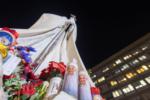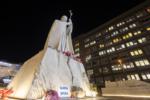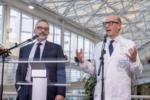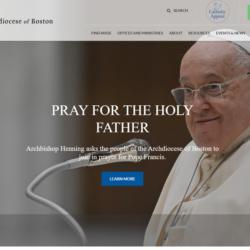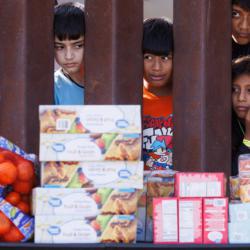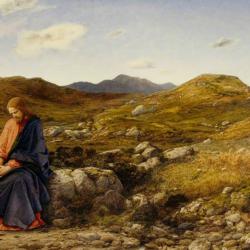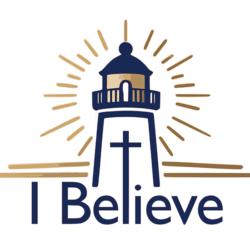Priests reflect on Boston busing crisis nearly 50 years later
BRAINTREE -- "The city of Boston is like your hand," explains Father William "Bill" Joy.
He points to the palm of his hand, representing downtown Boston. Then, he points to his fingers, representing the city's distinct neighborhoods -- Charlestown, Roxbury, etc. The neighborhoods, like fingers, stretch away from downtown and are separated from each other.
That was especially true back in 1974, when Father Joy was a 28-year-old priest assigned to St. Mary Parish in Charlestown. The community was close-knit and somewhat distrustful of outsiders.
"Townies take care of each other," said Father Joy, now 77, in an Aug. 22 interview.
Father Joy appears in the PBS documentary "American Experience: The Busing Battleground," which premiered nationwide on Sept. 11. The documentary opens with his Boston-as-hand metaphor.
Charlestown and South Boston were predominantly Irish Catholic. Roxbury, on the other hand, was predominantly Black. The two worlds rarely collided.
For decades, Boston's neighborhoods were segregated not by the letter of the law, as it was in the South, but by the way that local leaders organized the city's housing and school districts. Predominantly-Black schools were understaffed and underfunded compared to predominantly-white ones. In 1965, the Massachusetts Racial Imbalance Act outlawed segregation in public schools. However, it wasn't until 1974 that U.S. District Court Judge W. Arthur Garrity ruled that the Boston School Committee had unconstitutionally segregated white and Black students.
In 1974, Msgr. Frank Kelley was assigned to the predominantly-white St. Ambrose Parish in Dorchester.
"Black people were getting screwed," Msgr. Kelley, 82, recalled in a Sept. 21 interview. "They couldn't get a decent education in Boston."
The remedy for this was what came to be known as "busing." Eighteen-thousand Black and white students were required to get up, often before dawn, and take the bus to schools in each other's neighborhoods. Then-Cardinal Humberto Medeiros, the first non-Irish Archbishop of Boston in over 100 years, strongly supported busing, alienating many white Catholics. He told priests to ride on buses to keep the peace, and prevented families from enrolling their children in Catholic schools solely to escape busing. This decision made him even more controversial, and some Catholics opposed to busing felt that the archdiocese had turned its back on them. White and Black parents feared for their children's safety and did not want them going to schools in different neighborhoods -- schools which were often no better than the ones they were originally attending.
These developments, which occurred during a time of great change and uncertainty in all of Boston's neighborhoods, resulted in an explosion of violence, fear, racism, resentment, and political controversy that leaves a mark on the city to this day.
"The Gospel says we have to treat people as human beings," said Father Ron Coyne, 76, in a Sept. 12 interview. "We weren't treating one another as human beings."
In 1974, Father Coyne was assigned to the more diverse St. Angela Parish in Mattapan.
During the turmoil, neighborhood priests like Father Joy, Father Coyne, and Msgr. Kelley were looked to for guidance and healing.
"The Church didn't leave in spite of all that," Father Joy said. "The priests stuck with it and did the mundane things you do every day. Having Mass and visiting people."
Father Joy in Charlestown
When busing began, Father Joy witnessed angry confrontations between parents and police officers protecting the buses. St. Mary's Rectory was mere blocks from Charlestown High School, the epicenter of tensions.
He said that he "protected (people) from themselves," mediating to prevent physical violence.
The officers were often friends and relatives of those hurling verbal abuse at them.
"These guys, they'd get spit at and yelled at and called names," Father Joy said.
The officers would respond by reminding them of their families: "Hey Johnny, I know your mother. What would your grandmother say?"
Father Joy grew up in Hingham. His first exposure to Black people was when he played sports with Black students while attending Boston College High School. He discovered that they weren't that different from him.
When he first arrived in Charlestown, Father Joy saw a community in the midst of massive change, creating resentment that would boil over when busing started years later. The neighborhood, he said, "had no representation at all" in local and state government.
Charlestown had been cut off from the rest of Boston by the construction of new highways and the Tobin Bridge. Jobs were scarce, and few high school graduates went on to get a college education. Young men had no choice but to enlist and fight in the Vietnam War. If they came back alive, they were disillusioned and disrespected.
"People were angry at a lot of things," Father Joy said. "Society had left them behind. Their way of life was slowly disappearing."
Every night, anti-busing protesters would march on Bunker Hill Street and throw things at police officers.
Father Joy encouraged Charlestown residents to protest peacefully by praying the rosary at St. Mary's Church, which attracted media attention.
"Others would say, 'You're using the rosary for a bad issue,'" he said, "but that's their culture and their natural instinct. When you need something, you pray."
He said that while some of the resistance to busing in Charlestown was motivated by racism, that was not the only factor. Residents resented the fact that busing seemed to be imposed on them by outsiders such as Judge Garrity, who lived in Wellesley.
"It was poor people pitted against each other by those that weren't poor," Father Joy said.
It has often been said that busing caused enrollment in Catholic schools to skyrocket, but Father Joy called this an "urban myth." He pointed out that as white families moved to the suburbs to escape busing, they were just as likely to enroll their children in public schools there.
He added that Cardinal Medeiros "identified with the minority community" due to the discrimination he faced as an Azorean American, which influenced his decisions. Throughout the crisis, Cardinal Medeiros stuck to his values but tried to create as little conflict as possible.
"People wanted him to come to Charlestown," Father Joy said, "but he knew that if he went, it would only throw gasoline on the fire."
In 1975, Father Joy was interviewed about busing for Boston's Evening Compass news program. As he spoke, he stood between the impoverished Bunker Hill housing project and a brick wall that had the words "White Power" written on it.
"I think the Church has failed," Father Joy told the interviewer, "and by 'Church' I mean myself and everyone. We have not had enough credibility and visibility on our streets and neighborhoods."
He said that the Church was not empathetic enough to the "pressures" and "tensions" faced by residents of neighborhoods like Charlestown, and that there needed to be more priests on the streets. Forty-eight years later, he stands by his words.
"The Church could have been more present in the lives of everyday folks, and the priests could've been out of the rectories more," he told The Pilot.
Father Coyne in Mattapan
"Everyone was Catholic, everyone was a Democrat, everyone was Irish and Italian," Father Coyne said of his upbringing in West Roxbury. "That was the fact of life. I didn't have any experience with anyone who didn't look like me, talk like me, believe like me."
That changed when, as a seminarian, he visited a predominantly-Black parish in New Orleans. It was the first time he was surrounded by people from another culture.
When Father Coyne arrived in Mattapan, the neighborhood was in the process of integrating, but it wasn't easy. At St. Angela's youth center, he often found himself needing "to protect the Black kids from the white kids, and vice versa."
Nevertheless, he preached integration, but "it wasn't appreciated by everyone."
"For you to take a stand for someone else," he said, "an 'us versus them' kind of thing, can be very threatening to you and your congregation."
The tensions exploded when busing started. Father Coyne recalled hearing hateful and threatening language frequently. He rode the buses as Cardinal Medeiros had asked, and found that they were mostly peaceful because of past integration efforts in Mattapan. Looking back, Father Coyne believes that Cardinal Medeiros made the right decision by preventing anti-busing parents from enrolling their children in Catholic schools.
"I believe he reacted out of Gospel values," Father Coyne said. "However, people were so threatened by other issues in their lives that they couldn't see that. All they knew was that they wanted to get their child away from violence, away from unrest, and away from busing."
Msgr. Kelley in Dorchester
Every day during the busing crisis, Msgr. Kelley, teachers, FBI agents, and Boston police officers would stand outside of Grover Cleveland High School in Dorchester as school let out. Each day was filled with fear. Once, Msgr. Kelley remembered, a kid yelled "Bang!" and everyone fell to the floor.
"We really thought someone was trying to shoot at us," he said.
Msgr. Kelley grew up in Roslindale, which was predominantly white. He spent his transitional diaconate at the predominantly-Black St. Mary of the Angels Parish in Roxbury, which he would come to realize wasn't that different from Dorchester.
"They were very similar in that it was working-class, some poor," he said. "Just happened to have a different color. But at that point, I was young and naÏve, and I thought there was a big difference."
People of all races would interact relatively often in Dorchester due to the neighborhood's baseball field, shopping center, and train station. Much like Charlestown, the neighborhood was troubled by the Vietnam War and economic decline.
"People were struggling for jobs," Msgr. Kelley said. "You're burying kids in your own parish who had been in Vietnam."
He would aid in integration efforts by organizing with community leaders at the Dorchester House community center.
"That's a slow, slow, difficult process," he said. "Busing just blew that up. It was not a nice time."
While he remembered Dorchester as being "a hell of a lot more tolerant" than other neighborhoods, Msgr. Kelley heard a lot of "violent talk" and racist language. He refused to ride on the school buses.
"I said, 'No way I'm going to get on a bus into South Boston,'" he recalled. "You're crazy. I've got to deal with my own parish."
Like Father Joy, he believes that racism was only one of many reasons for the backlash to busing.
"There clearly were racist people," he said. "There are racist people here today. But I also felt like they were being put upon and used as an experiment . . . The Black families and the white families."
He remembers both white and Black residents being upset about their kids having to leave their neighborhoods each day.
"The city is a collection of small neighborhoods," Msgr. Kelley said, "and whether you're a liberal or a conservative, you're in your neighborhood. You can't disrupt that."
Lessons learned
In the aftermath of busing, white families left Boston for the suburbs in droves, a practice known as white flight. This radically altered the demographics of the city and its school system, keeping segregation in place. Busing still takes place in Boston, but on a much smaller scale due to a declining student population and new residents not having families.
Father Joy, Father Coyne, and Msgr. Kelley have seen their neighborhoods change drastically since then. From 1973 to 1978, Mattapan went from a majority-white neighborhood to a majority-Black one. Boston, and its archdiocese, have become much more diverse due to increased immigration. South Boston and Charlestown are home to fewer blue-collar families and more upper-class professionals without children. Today, many Bostonians consider busing to have been a well-intentioned failure, increasing the inequities it was supposed to get rid of.
"I think it was just an ill-conceived plan," Father Joy said. "You try to drive from South Boston to West Roxbury. You try to drive from South Boston to Jamaica Plain on a weekday morning."
The three priests said that their most important work during the busing crisis was done when they sat down and listened to the concerns of their parishioners.
"When you visit people at the hospital," Father Joy said, "when you're there at times of birth and death and marriage, you meet them on a human level. We spent a lot of time around kitchen tables talking to people. I think that you have to let them voice their frustrations and know there was someone willing to listen."
Father Coyne did as much as he could to listen, which he said is the obligation of all Catholics.
"As long as we live in our own little cocoon," he said, "it's easy to think that it's everyone's world. And it's very painful for people to realize that the way they were brought up is not necessarily the only way."
Msgr. Kelley said that the priests "tried a lot of things" during the busing crisis, but had no idea how to react to a situation they had never been in before.
Father Coyne had experience with diverse communities, but at that time, most priests did not.
"If you're not as comfortable with other religions, other nationalities, other cultures, and other ethnicities," he said, "then you're not comfortable. That's going to be why you may not be as apt to get involved in a situation like that."
The three priests agreed that both themselves and the Catholic Church handle diversity better than they did in 1974.
"I'm beyond blaming people," Msgr. Kelley said. "I'm as much at fault as anyone else. I realized that I had attitudes that were racially unacceptable, and I had to deal with that."
However, they also agreed that there is still work to be done, especially as immigrants shift the demographics of today's Church.
"How do you get up in front of people from 10 different countries and talk about their faith, their morals?" Msgr. Kelley asked. "Parish priests have to learn how to do that. How do you talk about race?"
Father Coyne views busing as a tragic conflict between "a lot of hardworking people trying to raise their children with values and principles," both white and Black.
"People deserve an equal share in this life," he said. "So if they feel they don't have that, they're going to fight for it."
"I think it was very well-done," Father Joy said about the documentary. "It portrayed things accurately from different sides, and it gave a very valuable background from the 1950s and '60s that people have to understand."



